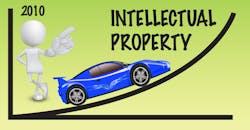Intellectual Property Markets: It’s Off to the Races
Download this article as a .PDF
Patents, trademarks, and copyrights are hardly new. Trademarks came first, in the 1200s in England. Patents were next, in the 1400s in Italy. Copyrights emerged in the early 1700s in England. For the United States, laws passed in the 1790s protected patents and copyrights. Trademark laws arrived in the 1870s following legislative activity throughout Europe. These are the three primary types of intellectual property (IP) that can be “registered” with governments for protection. Each are made public, and available statistics for all countries make it possible to track global activity.
Registered IP Boom: What is happening is not a surprise. There are several factors, besides globalization and competitiveness, that fuel the growth. First is the ability to monetize IP. IP used to be part of the price of a product. It still is, but it can also be sold or licensed or bartered in an increasingly liquid marketplace. Transactable IP, which began in the early 2000s, increased the size of the available market. Providers of software and services could now create many more capabilities than simply IP inventory management systems for companies.
Open innovation came of age a few years later, spurred by giants such as Procter & Gamble that set a goal to in-source 50% of their innovations from other companies. As the internet increasingly enabled global connectivity, big data and algorithmic analytics came of age. All the pieces were now in place to take a company’s IP portfolio and compare it to any company or set of global statistics.
Finally, coming full circle, this easily comparative global information spurred further growth as analysts warned companies about not keeping up with the Joneses. Geometric growth has been going on for the past five to seven years.
IP Networks: Another important growth driver are IP organizations that are not the actual governmental registration bodies. Western economic zones have assembled neighboring countries into consortiums and/or empowered agencies that oversee activities and influence country policies and legislation, such as Europe, Eurasia, the Arab States, and Africa. Asian countries appear to be taking a more solo approach.
On a larger scale, the World Intellectual Property Organization has become an increasingly important player. It was established in 1967 by the United Nations as a self-funding agency. It is located in Geneva, Switzerland, and represents 191 of 195 countries. WIPO, as it is known, is the global forum for IP services, policy, information, and cooperation. It is a great source of information on all registered IP. Get on their e-mail list and you will have your finger on the pulse.
Patents & Trademarks: There will always be regional, vertical, and other types of segment competitors, but a look at several WIPO’s global services likely portends the future of IP. WIPO offers three global registration platforms: for utility patents (PCT), design patents (Hague), and trademarks (Madrid). Users file a single “international application” directly with WIPO, which then handles the various country filings. This is a great assist for emergent countries and regions, and is also increasingly used by industrialized nations which already have plenty of infrastructure for registration and enforcement.
Copyrights: Copyrights are also increasingly being monetized. After the “free thinking” period when the internet boom began, the realization that content has value started to return. Giant companies and organizations around the globe now compete to gather and charge for access to their content. The list is long. Copyrights have a couple interesting twists. First is the ability to digitally identify every single publication, a systems capability that has been evolving since 1998. All major players now recognize Digital Object Identifiers (DOI) in their systems. Five billion DOIs are reconciled each year. Second, in 2008, Thomson-Reuters launched ResearcherID, which enabled the unique identification of authors, which was followed by a more open-to-the-public ORCID system in 2012. Five million authors are now registered in ORCID.
Does it sound to you like the future of registered IP is headed to be a transactable commodity?
About the Author
Bradford Goldense
Contributing Technical Expert
Bradford L. Goldense is founder and president of Goldense Group, Inc. [GGI] (www.goldensegroupinc.com), a consulting, market research, and education firm focused on business and technology management strategies and practices for product creation, development, and commercialization. He has been an adjunct faculty member of the graduate engineering school at Tufts University's Gordon Institute for 19 years. Goldense is a Certified New Product Development Professional [NPDP], a Certified Manufacturing Engineer [CMfgE], a Certified Computer Professional [CCP], and is Certified In Production & Inventory Management [CPIM]. He holds over 200 registered copyrights and is a recognized subject-matter expert, including appearances on PBS and CNBC. He has consulted to over 250 companies and over 750 manufacturing locations on four continents since founding GGI in 1986. Goldense holds an MBA in Accounting from the Cornell Johnson School and a BSCE from Brown University. For more information, please see Brad's LinkedIn profile or visit GGI's home page.

